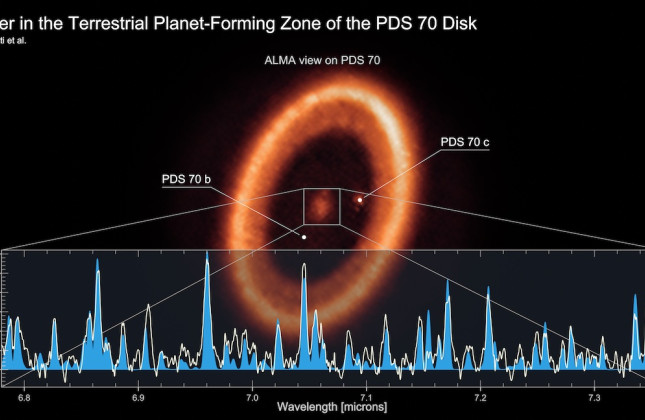At issue is the inner disk of gas and dust around the young star PDS 70. Astronomers expect earth-like planets to form in this zone. This is the first sighting of water at a stage when the disk has already lost most of its material. Any rocky planet arising in the inner disk would benefit from a significant local water reservoir, increasing the likelihood of ‘habitability’ at a later stage. This discovery constitutes evidence for a mechanism to supply potentially habitable planets with water already during their formation, in addition to any water that may arrive as a result of later asteroid impacts.
Water is essential for life on Earth. However, scientists are still debating how water reached Earth, and whether this process could also make rocky exoplanets around other stars habitable. The preferred mechanism is supply by water-bearing asteroids bombarding the surface of a young planet. “We may now have found evidence that water could also serve as one of the first ingredients of rocky planets and be available immediately after their birth,” says Giulia Perotti, astronomer at MPIA and lead author of the paper describing the discovery of water in the planet-forming disk of the young star PDS 70, approximately 370 light years away from Earth.
Inner disk
Observations with the Mid-InfraRed Instrument MIRI aboard the James Webb Space Telescope (JWST) detected water near the centre of the disk, close to its parent star PDS 70. In our solar system, this is the region where rocky planets orbit the sun. According to the analysis, the water is hot vapour at a temperature of no less than 230 degrees Celsius. “This discovery is very exciting because it involves the region where rocky planets like Earth normally form,” says MPIA Director Thomas Henning, co-author of the paper, MIRI co-investigator and principal investigator of the MIRI Mid-Infrared Disk Survey (MINDS) programme.
MINDS is a programme with guaranteed JWST time that brings together research institutes from 11 European countries. The aim of this programme is to identify the properties of disks of gas and dust around young stars, thus gathering information about the conditions that determine the composition of planets that can form there.
PDS 70 is the first relatively old disk – it's approximately 5.4 million years old – where astronomers have found water. Over time, the gas and dust content of planet-forming disks decreases; radiation from the central star or stellar wind removes material such as dust and water vapour, or the dust grows into larger objects that eventually form planets.
Because previous studies found no water in the central regions of disks that evolved in a similar way, astronomers suspected that water might not survive the star's radiation, leading to an environment where dry rocky planets could form. This hypothesis has been refuted with this study. Astronomer and co-author Rens Waters (Radboud University): “The inner edges of evolved and low-dust disks may not be as dry as we previously thought. If this is true, many terrestrial planets arising in those zones could well be born with a key ingredient that makes life possible.”
No planets have so far been found near the centre of the PDS 70 disk. Astronomers did discover two gas giants further away: PDS 70 b and c. As they grew, these planets accumulated dust and gas as they orbited their parent star, creating a wide ring-shaped gap containing almost no observable material. The progress of the MINDS programme will eventually reveal whether water commonly occurs in the zones where Earth-like planets can form in the evolved disks around young stars, or whether PDS 70 is an exception.
Origin of the water
Because the presence of water was somewhat unexpected, the MINDS team is investigating different scenarios to explain their find. One possibility is that the water is a remnant of a watery mist that preceded the disk phase. Water is quite common, especially when frozen, and covers small particles of dust. When exposed to heat near a star being formed, this water evaporates and mixes with the other gases. Unfortunately, water molecules are quite fragile and break into smaller components such as hydrogen and oxygen when hit by the harmful UV radiation from the nearby star. However, surrounding material such as dust and the water molecules themselves serve as a protective shield.
Another source could be gas coming in from the outer edges of the PDS 70 disk. Under certain conditions, oxygen and hydrogen gas can combine to form water vapour. In addition, the very smallest ice-covered dust particles can still reach the inner disk because they flow in with the gas.
The central star is so dim that it cannot vaporise the water ice at the distance of that ring. It is only when the tiny dust grains reach the inner disk close to the star that the ice turns to gas. “The truth probably lies in a combination of all these possibilities,” says co-author Inga Kamp (University of Groningen). “And yet, there is probably one mechanism that plays a decisive role in maintaining the water reservoir of the PDS 70 disk.” What mechanism that is, is the subject of further research. The astronomers have already made additional observations with ground-based telescopes to complete the picture. They are also eagerly awaiting a new series of JWST observations that will provide detailed images of the inner disk of PDS 70. They hope the disk's structure will reveal hints about terrestrial planets or the somewhat larger ‘sub-Neptunes’ that could be formed in the water reservoir.
